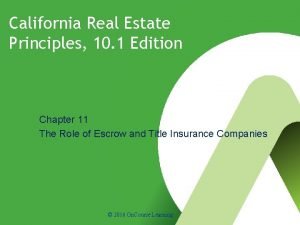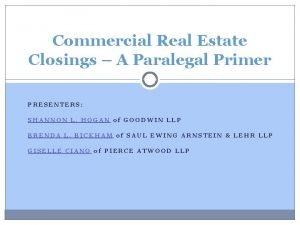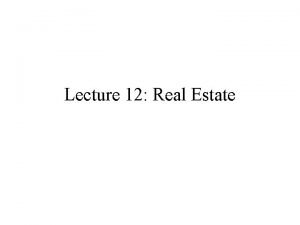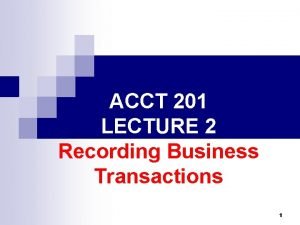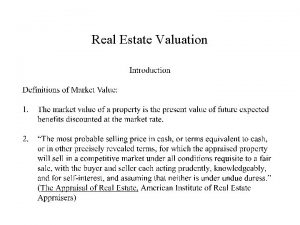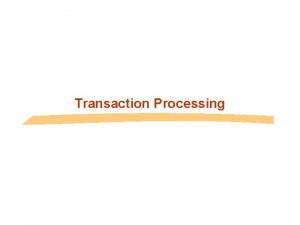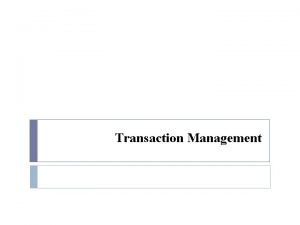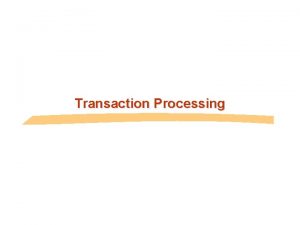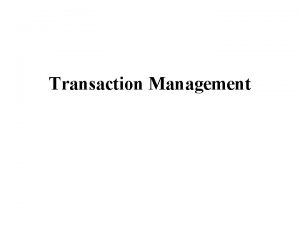Closing the Real Estate Transaction LECTURE OUTLINE I














- Slides: 14

Closing the Real Estate Transaction LECTURE OUTLINE: I. Pre-closing Procedures A. Consummation of real estate transaction 1. Promises made in sales agreement fulfilled. 2. Mortgage loan funds distributed 3. Title transferred B. Buyer’s issues The buyer will want to be assured that 1. The seller is delivering good title. 2. The property is in the promised condition. Inspecting a. the title evidence b. the seller’s deed c. any documents regarding removal of liens and encumbrances d. the survey e. the results of property inspection f. any leases

Closing the Real Estate Transaction C. D. E. F. Final property inspection to make certain 1. necessary repairs made 2. property is well maintained 3. fixtures are in place 4. no unauthorized removals or alterations Survey Seller’s issues. The seller will want to be assured that 1. The buyer has obtained the stipulated financing. 2. The buyer has sufficient funds to complete the sale. Title procedures 1. The buyer needs to be assured that the seller's property and title comply with the contract requirements. 2. The seller is usually required to show proof of ownership by producing current title evidence (form that is customary in your area). 3. The title or abstract company usually makes two title searches. a. The first shows the seller's status as of the contract date. b. The second is made for the date the deed is recorded. c. The seller may be required to execute an affidavit of title. In areas where closed in escrow, not needed.

Closing the Real Estate Transaction II. Conducting the Closing A. Terminology varies by geographic region 1. Settlement and transfer 2. Passing the papers 3. Escrow B. Face-to-face closing the gathering of the parties interested in the real estate transaction at which the promises made in the real estate sales contract are kept or executed 1. Two closings can occur a. The closing of the buyer's loan b. The closing of the sales transaction 2. May be held at a. The title insurance company b. The lending institution c. One of the parties' attorneys office d. The broker's office e. The county recorder (or other local recording official) office f. The escrow company

Closing the Real Estate Transaction 3. C. May be attended by a. The buyer b. The seller c. The real estate licensees (brokers and salespeople) d. The attorney(s) for the seller and the buyer e. The representative of the involved lending institutions f. The representative of the title insurance company 4. The closing agent or closing officer the person who presides over the closing. 5. The exchange; made when all parties satisfied that everything is order. Closing in escrow 1. The method of closing in which a disinterested third party is authorized to act as the escrow agent and coordinate the closing activities. 2. Because the escrow agent is placed in a position of trust, many states have laws regulating escrow agents and limiting who may serve in this capacity.

Closing the Real Estate Transaction D. Escrow Procedure 1. After escrow agent selected and contract signed, broker deposits Earnest money with escrow agent. 2. Before the closing, the seller will deposit with the escrow agent a. The deed conveying the property to the buyer b. Title evidence (whatever is customary in your area) c. Existing hazard insurance policies d. A letter from the lender and an estoppel certificate stating the exact principal remaining if the buyer is assuming the seller's loan e. Affidavits of title (if required) f. A reduction certificate (payoff statement) if the seller's loan is to be paid off g. Other documents necessary to clear the title or complete the transaction

Closing the Real Estate Transaction 3. 4. Before the closing, the buyer will deposit with the escrow agent a. The balance of the cash needed to complete the purchase, usually in the form of a certified check b. Loan documents if the buyer is securing a new loan c. Proof of hazard insurance, including, if required, flood insurance d. Other documents necessary to complete the transaction The escrow agent is given the authority to examine the title evidence a. If the title is marketable and all other conditions are met, the escrow agent will disburse the funds and record the documents. b. If the title has liens, they will be paid off first. c. If the sale cannot be completed, the parties will be restored to their former status.

Closing the Real Estate Transaction E. IRS reporting requirements Form 1099 -S 1. Contains the seller's social security number, sales price and the amount of property tax that was reimbursed to the seller by the buyer (seen as income by the IRS) 2. Must be filed by the closing agent; if this person does not the responsibility rests on the mortgage lender or ultimately the brokers involved. F. Broker's role at closing varies from simply collecting the commission to conducting the proceedings G. Lender's interest in closing to protect its security interest in the property, the lender can require 1. A title insurance policy 2. A fire and hazard insurance policy 3. A survey 4. A termite or other inspection report 5. A certificate of occupancy (for newly-constructed buildings) 6. Reserve or escrow accounts for tax and insurance payments 7. Representation by its

Closing the Real Estate Transaction III. RESPA Requirements A. Purpose 1. To provide consumers with greater and more timely information on the nature and costs of settlement 2. To eliminate "kickback" and other referral fees that tend to unnecessarily increase the costs of settlement and B. RESPA requirements must be complied with when the purchase of a one-to-four-family residential unit is financed by a federally-related new first mortgage loan 1. Made by a federally-chartered lending institution 2. Made by an institution whose deposits are federally-insured 3. FHA-insured 4. VA-guaranteed 5. Administered by HUD 6. Intended to be sold to Fannie Mae, Ginnie Mae, or Freddie Mac

Closing the Real Estate Transaction C. Exceptions to the "new loan" requirement 1. 2. 3. 4. purchase money mortgages Installment sales (land contracts) buyer’s assumption of existing mortgage no exception if a. the terms of assumed loans are modified b. Assumed loans for which the lender charges more than $50 for the assumption D. Controlled business arrangements (CBAs) affiliated firms offer package of services to consumers. 1. The relationship between the firms must be disclosed in writing to consumers. 2. Consumers must be free to obtain the services elsewhere. 3. Fees are not exchanged among the affiliated companies simply for the referral of business.

Closing the Real Estate Transaction E. F. Disclosure requirements 1. The lender must give a copy of special informational HUD booklet to every person from whom they receive or for whom they process a loan application. 2. Within three business days of the loan application, the lender must provide the borrower with a good-faith estimate of the settlement costs the borrower is likely to incur. 3. The loan closing information must be prepared on the Uniform Settlement Statement (HUD Form 1) and available for inspection at or before settlement. Kickbacks and referral fees 1. Kickbacks and unearned referral fees are prohibited. 2. The payment or receipt of any fee or thing of value where no service is actually rendered is prohibited.

Closing the Real Estate Transaction III. Preparation of Closing Statements (See Figure 22. 1) A. How the closing statement works (See Figure 22. 2) 1. A debit is a charge (an expense). 2. A credit is an amount entered in a person's favor. B. The buyer's debits and credits are totaled; when the credits are subtracted from the debits, the difference is the cash the buyer must bring to the closing. C. The seller's debits and credits are totaled; when the debits are subtracted from the credits, the difference is the amount the seller will receive at closing. D. Expenses (See Figure 22. 2) 1. Broker's commission 2. Attorney's fees 3. Recording expenses 4. Transfer tax 5. Title expenses 6. Loan fees 7. Tax reserves and insurance reserves (escrow or impound accounts) 8. Appraisal fees 9. Survey fees 10. Additional fees

Closing the Real Estate Transaction IV. Prorations expenses divided between the seller and the buyer, including accrued items (such as real estate taxes) and prepaid items (such as fuel oil in a tank) A. The arithmetic of prorating 1. Four considerations a. the nature of item being prorated b. whether it is accrued item requiring determination of earned amount c. whether it is prepaid item that requires the unearned amount refunded d. what arithmetic processes must be used. B. Accrued and prepaid items 1. accrued items = buyer credit 2. prepaid items = seller credit

Closing the Real Estate Transaction C. General rules for calculating prorations 1. The yearly charge is divided by a 360 -day year (commonly called a banking year) or twelve months of 30 days each. 2. The yearly charge is divided by 365 (366 in a leap year) to determine the daily charge; then the actual number of days in the proration period is determined; and this number is multiplied by the daily charge. 3. The final figure will vary depending on the method used and the number of decimal places to which the division is carried. 4. Guidelines a. In most states, the seller owns the property on the day of closing and prorations are made to and including that date. b. Prorations are computed using a 30 -day month and a 360 -day year or using the actual number of days in the month in a 365 day year (refer to area practices). c. Accrued real estate taxes are usually prorated; special assessments for public improvements are not.

Closing the Real Estate Transaction d. Rents are usually prorated based on the actual number of days in the month of closing. e. Security deposits belong to the tenants and must be transferred intact from the seller to the buyer. 5. Real estate taxes a. If they are paid in advance, the seller should be reimbursed for the portion of the year remaining after the buyer takes ownership. b. If they are paid in arrears, the buyer is credited for the time the seller was occupying the property. 6. Mortgage loan interest usually paid in arrears V. Sample Closing Statement A. The Uniform Settlement Statement (HUD Form 1) (see Figure 22. 3) B. Basic information of offer and sale C. Computing the prorations and charges D. The Uniform Settlement Statement
 Closing statements real estate
Closing statements real estate Paralegal real estate closing checklist
Paralegal real estate closing checklist Real estate lecture
Real estate lecture 11245 lantern road fishers in 46038
11245 lantern road fishers in 46038 Recording business transactions
Recording business transactions 01:640:244 lecture notes - lecture 15: plat, idah, farad
01:640:244 lecture notes - lecture 15: plat, idah, farad Lecture outline example
Lecture outline example Lecture outline example
Lecture outline example Lecture outline example
Lecture outline example Lecture outline meaning
Lecture outline meaning Realtor elevator pitch examples
Realtor elevator pitch examples What is a mofir
What is a mofir Real estate stakeholders
Real estate stakeholders Greek real estate market
Greek real estate market Sandy miller realtor
Sandy miller realtor
